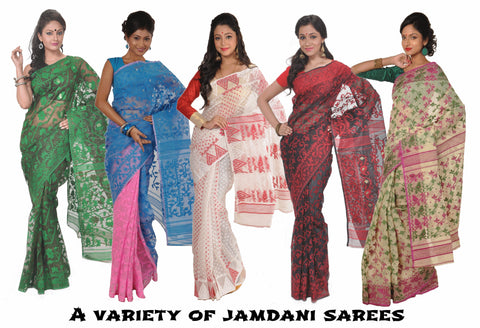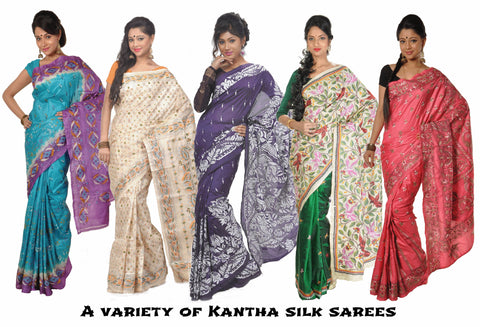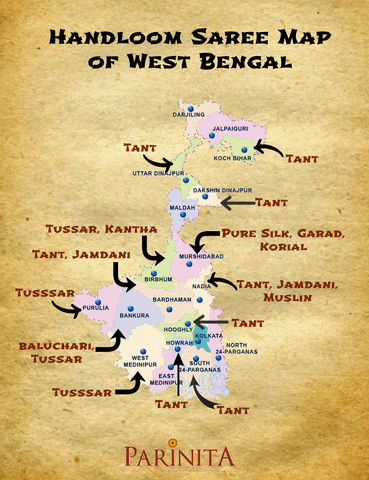About Bengal Handlooms
Read about various facts & figures on Bengal handloom sarees ...
- How to identify your Bengal handloom sarees?
- The handloom map of West Bengal
- The famous red & white Bengali sarees
- Sarees for Durga Puja
How to identify your Bengal handloom sarees?
Unless you grew up in a traditional Bengali family, you may often find it confusing to distinguish a garad saree from a korial or a jamdani from a muslin. They often look similar from a distance and only knowing the characteristics of each saree will help you identify them correctly. Here’s a quick overview on the different types of handloom sarees from West Bengal.


3. Muslin: A muslin saree (also called ‘dhakai muslin’) is an ultra-fine saree in an exotic sheer fabric with a glossy texture. Delicate motifs are woven on the transparent sarees in a manner similar to jamdani sarees. Weaving these sarees is a very skilful and laborious art, making these among the most expensive sarees from the region.

4. Garad: A garad is a pure silk saree characterized by a plain white or off-white body and a simple coloured border and a striped pallav. The most popular garad sarees have a red border and pallav, but they are also available in other colours.

5. Korial: A korial saree (also called ‘garad-korial’) is a grand version of the simple garad saree. Like the garad, it has a white or off-white silk body and a coloured border and pallav. The texture of the silk is richer in a korial saree, and it is decorated with more ornamental and intricate motifs.

6. Baluchari: A baluchari is one of the most gorgeous silk sarees from Bengal. It is characterised by an exotic border and elaborate pallav filled with intricate weavings depicting scenes from ancient epics and religious texts. The weavings are done in colours that stand out in contrast against the silk base of the saree. The most opulent baluchari sarees have weavings done in gold and silver coloured threads.

7. Tussar: A tussar silk saree has a natural, pale golden sheen. When undyed, these sarees come in shades of beige, cream, honey or tawny. They are often dyed to take up more vibrant colours. The traditional tussar silk sarees from West Bengal are defined by decorative woven borders and pallav and the motifs used are similar to those in tant and jamdani sarees.

8. Murshidabad silk: Murshidabad is a district in West Bengal known for weaving silk of very good quality. Fine, light-weight pure silk sarees from this region are very popular as formal and casual wear. They are easy to drape and come in a variety of colourful, printed designs. These sarees are collectively known as ‘Murshidabad silk’ sarees.

9. Kantha: Kantha a style of embroidery that originated in the Bolpur-Santiniketan region of West Bengal, and is widely used to pattern sarees in all kinds of fabrics. The kantha embroidery is characterized by the 'running stitch', which is always done by hand using coloured threads, and can form very elaborate and intricate patterns. The beauty of kantha work is best featured on pure silk and tussar silk sarees.

So that's it! Hope you now have a fairly good idea about the various types of Bengal handloom sarees and will be able to identify these gorgeous drapes when you see them...
The Handloom Map of West Bengal

West Bengal has a rich heritage of handloom weaving, and sarees occupy an important place in this cultural legacy. From an economic standpoint, handlooms come second only to agriculture in providing livelihood to the rural population of the state. Every district has weaving ‘clusters’, which are home to artisan communities, each specializing in specific varieties of handloom weaving.
The map here illustrates the key regions of origin of the famous cotton and silk sarees from West Bengal. Here is an overview of the well-known handloom products of each district in the state:
- Darjeeling: Woollen shawls, coarse cotton sarees
- Jalpaiguri: Cotton towels (also called ‘gamchha’), coarse cotton sarees
- Koch Bihar: Tant sarees, fine and coarse cotton sarees
- Uttar Dinajpur: Tant sarees, fine cotton sarees
- Dakshin Dinajpur: Tant sarees, fine cotton sarees
- Maldah: Cotton towels, lungi, coarse cotton sarees
- Murshidabad: Pure silk sarees, Garad & Korial sarees, silk fabric & shirts, cotton towels, coarse cotton sarees
- Birbhum: Tussar sarees, Tussar fabric & shirts, Kantha work
- Bardhaman: Tant & Jamdani sarees, fabric for scarves, stoles & home furnishings, coarse sarees, cotton towels, lungi, dhoti, handspun cotton shirts
- Nadia: Tant, Jamdani & Muslin sarees, dress materials, fabric for scarves & stoles, coarse cotton sarees, cotton towels & lungi
- Purulia: Tussar sarees, Tussar fabric & shirts, coarse cotton sarees, cotton towels
- Bankura: Baluchari & Tussar sarees, silk & Tussar fabric, shirts & scarves, cotton towels, fabrics for home furnishings
- West Medinipur: Tussar sarees, fine & coarse cotton sarees, cotton shirts & towels
- East Medinipur: Coarse cotton sarees, cotton shirts, furnishings & towels
- Hooghly: Tant sarees, fine cotton sarees, dhoti, coarse cotton sarees
- Howrah: Tant sarees, cotton shirts, dhoti, furnishings & towels, coarse cotton sarees
- North 24 Parganas: Coarse cotton sarees, cotton towels & lungi
- South 24 Parganas: Tant sarees, fine & coarse cotton sarees, cotton towels
- Kolkata: Not a weaving center, but has the largest markets for all handloom products from West Bengal
Reference: “West Bengal Handloom Map”, Retrieved 26 June 2015, from http://www.westbengalhandloom.org/htm/h_map.html
The Famous Red & White Bengali sarees
If you recall any movie that was set in Kolkata, you will remember at least one scene depicting Bengali women draped in traditional white sarees with red borders. These are indeed among the most well-known and sought after sarees from this region.
Why red and white?
The combination of red on white is considered very auspicious by Bengali women. White stands for purity while red symbolizes her fertility. A white or off-white saree with a red border and pallav is often the attire of choice of a married woman for devotional events, religious ceremonies or commemorative functions. These sarees are often accessorized with white bangles made of conch shells (called “shakha”) and red coral bangles (called “pola”), along with red sindoor on the forehead, all symbols of her marital status.
What kind of sarees are these?
Red-n-white sarees are available in all textures and price ranges. The simplest cotton sarees are available for a few hundred rupees while the most gorgeous silks could even cost several thousands. One can choose an appropriate saree based on her budget, taste and the importance of the event where she plans to wear it.
Common varieties of red and white sarees:
Tant: Typical tant sarees in this combination have a white or off-white cotton base, a red border often with gold zari work, an artistic pallav and small red motifs strewn across the body of the saree.
Jamdani: The jamdani sarees have a sheer white base in cotton or silk and fine red motifs in cotton woven all over the body giving it a grand finish. The motifs are usually traditional, ranging from simple polkas to more elaborate paisley and floral designs.
Garad and Garad-Korial: The most popular garad saree comes with a plain white silk base, a broad red border and a striped pallav. Variations of this have striped borders and small red motifs woven across the white base of the saree. Garad-korial sarees are more elaborate with intricate motifs in red or gold woven in the body and pallav. The silk in garad sarees is very fine and has a papery texture.
Tussar: The tussar silk sarees have a beige or off-white base with a golden sheen. The borders are in red or red-gold, and the pallav has elaborately woven motifs in red. The patterns in the traditional tussar silk sarees are quite similar to those of tant sarees.
Muslin: The muslins are super-fine and exotic versions of the jamdani sarees. The white base of the saree is extremely light and sheer and is adorned with delicate weavings in red, giving it a luxurious finish.
Korial-Banarasi: These are lavish silk sarees with a plush white or off-white base and gorgeous gold/silver embellishments that are characteristic of Banarasi silks, adorning the red border and pallav of the sarees.
Baluchari: Baluchari silk sarees in the red and white combination are very exquisite to drape and behold. The borders and pallav are intricately adorned with red motifs depicting tales from epics and religious texts. The rich white base complements the gorgeous borders and often has delicate red motifs woven across. A touch of gold zari amidst the red weavings can further enhance its grandeur.

Sarees for Durga Puja
If there is one time of the year when Bengalis buy new clothes for the entire family, it is during the grand festival of Durga Puja, or known simply as Pujo. Celebrated during the last 4 days of Navratri, culminating months of elaborate preparations, it is marked by worship, feasting, pandal hopping, and of course, dressing up.
Here’s a quick guide to the sarees that Bengali women typically choose to wear during each day of the Durga Puja celebrations.
- Saptami (7th day of Navratri): Saptami morning starts with a visit to the neighbourhood pandal. Light tant or dhakai cotton sarees with minimal makeup are a good way to begin the Devi darshan. The evenings are a grander affair with lavish silks for visiting pandals all over town with friends and relatives.
- Ashtami (8th day of Navratri): Ashtami is the biggest day of Durga Puja when all nine forms of the goddess are worshipped. On this day, the famous red-n-white Bengali saree is draped in the morning to offer pushpanjali to the goddess. It could be a simple white tant saree with a red border, or an off-white garad silk with a broad red border. Married women further adorn themselves with white bangles made of conch shells (called “shakha”) and red coral bangles (called “pola”), along with red sindoor on the forehead, all symbols of her marital status. Older women or women who have lost their husbands drape white or off-white tant/garad sarees with the border in a colour other than red (orange, blue, green, etc.). Garad-korial silks, which are more elaborate forms of the garad sarees may also be worn. Ashtami evenings are reserved for the most gorgeous outfits of the festival season. Brilliant kanthas, ravishing jamdanis, sublime muslins, exquisite balucharis, stunning silks from other regions or even stylish contemporary sarees are worn for the festivities.
- Navami (9th day of Navratri): Navami mornings are again a simpler affair with a light saree such as a tussar silk or jamdani, while the evenings see more luxurious drapes, for the final pandal hopping, feasting, cultural performances and other celebrations.
- Vijaya-Dashami (or Dussehra): Vijaya-Dashami marks the end of Durga Puja, where all gather to bid farewell to the goddess. The red-n-white saree is again donned by women on this day to apply sindoor to the goddess and her four children (Lakshmi, Saraswati, Ganesh and Karthik) and also on each other’s foreheads in a fun-filled ceremony called ‘sindoor khela’.
